This qualitative interview study (n=17) of those receiving esketamine (35-210mg/70kg, 12x over 6w) for depression explores patients’ experiences. Findings reveal highly variable effects of ketamine with common psychological distress, and central themes include perceptual effects, detachment, stillness and openness, mystical-type effects, fear and anxiety, feeling hungover and tired, and a neutralizing mood effect post-session. While patients reported several esketamine effects with psychotherapeutic potential such as increased openness, detachment, and mystical-type experiences, the study identifies a need for additional support due to the frequency and severity of the perceived distress during the treatment.
Abstract of Phenomenology and therapeutic potential of patient experiences during oral esketamine treatment for treatment-resistant depression
“Background Ketamine and its enantiomers are widely researched and increasingly used to treat mental disorders, especially treatment-resistant depression. The phenomenology of ketamine-induced experiences and their relation to its psychotherapeutic potential have not yet been systematically investigated.
Aims To describe the phenomenology of patient experiences during oral esketamine treatment for treatment-resistant depression (TRD) and to explore the potential therapeutic relevance of these experiences.
Methods In-depth interviews were conducted with 17 patients after a 6-week, twice-weekly ‘off label’ generic oral esketamine (0.5–3.0mg/kg) treatment program. Interviews explored participants’ perspectives, expectations, and experiences with oral esketamine treatment. Audio interviews were transcribed and analyzed using an Interpretative Phenomenological Analysis (IPA) framework.
Results The effects of ketamine were highly variable, and psychological distress was common in most patients. Key themes included (a) perceptual effects (auditory, visual, proprioceptive), (b) detachment (from body, self, emotions, and the world), (c) stillness and openness, (d) mystical-type effects (transcendence, relativeness, spirituality), and (e) fear and anxiety. Key themes related to post-session reports included (a) feeling hungover and fatigued, and (b) lifting the blanket: neutralizing mood effects.
Conclusion Patients reported several esketamine effects with psychotherapeutic potential, such as increased openness, detachment, an interruption of negativity, and mystical-type experiences. These experiences deserve to be explored further to enhance treatment outcomes in patients with TRD. Given the frequency and severity of the perceived distress, we identify a need for additional support in all stages of esketamine treatment.”
Authors: Joost J. Breeksema, Alistair Niemeijer, Bouwe Kuin, Jolien Veraart, Eric Vermetten, Jeanine Kamphuis, Wim van den Brink & Robert Schoevers
Summary of Phenomenology and therapeutic potential of patient experiences during oral esketamine treatment for treatment-resistant depression
Research into the antidepressant potential of ketamine has increased since the early 2000s. Its psychoactive effects include altered perceptual processes, altered proprioception, alterations in consciousness, detachment from the world or self, and occasionally ‘mystical’ experiences.
Ketamine and its enantiomers are a regular pharmacological treatment without explicit psychological support or psychotherapy. Some therapists integrate ketamine administrations in a broader psychotherapeutic framework as ketamine-assisted psychotherapy, but no evidence-based treatments exist.
Find this paper
https://doi.org/10.1007/s00213-023-06388-6
Open Access | Google Scholar | Backup | 🕊
Cite this paper (APA)
Breeksema, J. J., Niemeijer, A., Kuin, B., Veraart, J., Vermetten, E., Kamphuis, J., ... & Schoevers, R. (2023). Phenomenology and therapeutic potential of patient experiences during oral esketamine treatment for treatment-resistant depression: an interpretative phenomenological study. Psychopharmacology, 1-14.
Study details
Compounds studied
Ketamine
Topics studied
Treatment-Resistant Depression
Depression
Study characteristics
Interviews
Qualitative
Participants
17
Humans
Authors
Authors associated with this publication with profiles on Blossom
Joost BreeksemaJoost J. Breeksema, PhD is a postdoctoral researcher at the UMCG, and executive director of the OPEN Foundation, its biannual ICPR conference and their comprehensive therapist training program ADEPT (launched in 2025). He is one of the central connectors in the (European) psychedelic space.
Compound Details
The psychedelics given at which dose and how many times
Ketamine 35 - 210mg | 12x
Linked Research Papers
Notable research papers that build on or are influenced by this paper
Ketamine treatment for individuals with treatment-resistant depression: longitudinal qualitative interview study of patient experiencesThis longitudinal interview study (n=12) examined the subjective expectations and effects of ketamine treatment (35mg/70kg) in a population with treatment-resistant depression (TRD). The study found high expectations, side-effects for most (11/12), a reduction in suicidal ideation (SI) for many (8/12) but for some (3/12) more SI when treatment effects decreased (1 week later).

